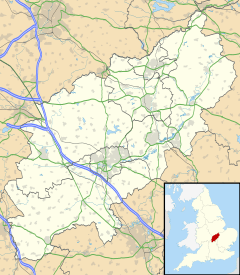Furtho facts for kids
Quick facts for kids Furtho |
|
|---|---|
 Manor Dovecote (left foreground) and St Bartholomew's church (right background) |
|
| OS grid reference | SP772429 |
| • London | 55 miles (89 km) |
| Civil parish |
|
| Unitary authority |
|
| Ceremonial county | |
| Region | |
| Country | England |
| Sovereign state | United Kingdom |
| Post town | Towcester |
| Postcode district | MK19 6 |
| Dialling code | 01908 |
| Police | Northamptonshire |
| Fire | Northamptonshire |
| Ambulance | East Midlands |
| EU Parliament | East Midlands |
| UK Parliament |
|
| Website | Potterspury Parish Council |
Furtho is a fascinating place in Northamptonshire, England. It used to be a small village, but now it's known as a deserted medieval village. This means it was once a busy community that slowly became empty over many years. Today, Furtho is part of the larger area called Potterspury. In 1931, only 25 people lived in the parish of Furtho.
The name "Furtho" might mean "before the hill-spur" or "ford hill-spur." A "ford" is a shallow place in a river where you can cross.
Furtho is located east of Potterspury and west of Cosgrove. It's about 2 miles (3.2 km) northwest of Stony Stratford. The closest towns are Wolverton, about 3 miles (4.8 km) to the southeast, and Towcester, about 5 miles (8 km) to the northwest.
Contents
The Furtho Manor
A "manor" was like a large estate or a big house with all the land around it. Furtho was a parish that covered about 693 acres (2.8 sq km). One side of its land was next to the River Tove.
In 1086, a very old record called the Domesday Book mentioned three estates in Furtho. By the 1240s, a man named Walter de Furtho owned the largest of these estates. Later, in 1452, William Fortho, an important local person, lived in Furtho.
Why the Village Became Empty
The Furtho family played a big role in why the village became empty. In the late 1500s and early 1600s, they started "inclosing" their land. This meant they fenced off the open fields that villagers used to share. In 1572, Thomas Furtho gave villagers smaller plots of land in exchange for their old ones. He also made them give up their ancient right to use a path to Watling Street, an old Roman road.
By 1621, Edward Furtho, who was part of the family, died without children. His estate then went to his sisters. Over time, parts of the estate were sold off to other families.
The Surviving Dovecote
Even though the original manor house is gone, a special building from the 15th century still stands. It's called a dovecote. A dovecote is a building where pigeons or doves were kept. People used them for food or for their droppings, which were used as fertilizer.
The Furtho dovecote has been repaired twice, in 1917 and 1990. It now has a cone-shaped roof that was added in the 20th century. This dovecote is a Grade II* listed building. This means it's a very important historical building that needs to be protected.
Today, there's a "Furtho Manor Farm" nearby. But it's a newer building made of red brick and isn't connected to the old manor house. It now serves as a guest house.
St Bartholomew's Church
The Church of England parish church of St Bartholomew is another old building in Furtho. Parts of the church date back to the 12th and 14th centuries. However, most of it was rebuilt in 1620.
The church was last used for regular worship in 1921. After that, its church area (called an ecclesiastical parish) joined with the church of St Peter's in Potterspury.
Today, St Bartholomew's Church is looked after by the Churches Conservation Trust. This group helps to protect historic churches that are no longer used for regular services. Like the dovecote, St Bartholomew's is also a Grade II* listed building.
Changes Over Time
By the 1720s, only four houses were left in Furtho. By the 1830s, this number had dropped to just two. This shows how much the village had shrunk.
On April 1, 1951, the parish of Furtho was officially removed. Its land was then added to the nearby parishes of Potterspury, Cosgrove, and Old Stratford. This was the final step in Furtho becoming a deserted village.


